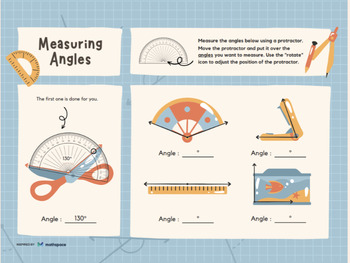>>GEOMETRY
Kim Barnett
0 Followers
Grade Levels
3rd - 6th
Subjects
Resource Type
Standards
CCSS3.MD.C.5
CCSS3.MD.D.8
CCSS4.MD.A.3
CCSS4.MD.C.5
CCSS4.MD.C.5a
Formats Included
- Zip
Kim Barnett
0 Followers
Products in this Bundle (16)
showing 1-5 of 16 products
Description
This bundle includes handouts, an activity, a game, and practice worksheets. It includes everything from geometry vocabulary, classifying triangles and quadrilaterals, symmetry, angle measurement, finding missing angle measurement, area and perimeter of triangles, to geometric translations.
Total Pages
Answer Key
N/A
Teaching Duration
N/A
Last updated 2 months ago
Report this resource to TPT
Reported resources will be reviewed by our team. Report this resource to let us know if this resource violates TPT’s content guidelines.
Standards
to see state-specific standards (only available in the US).
CCSS3.MD.C.5
Recognize area as an attribute of plane figures and understand concepts of area measurement.
CCSS3.MD.D.8
Solve real world and mathematical problems involving perimeters of polygons, including finding the perimeter given the side lengths, finding an unknown side length, and exhibiting rectangles with the same perimeter and different areas or with the same area and different perimeters.
CCSS4.MD.A.3
Apply the area and perimeter formulas for rectangles in real world and mathematical problems. For example, find the width of a rectangular room given the area of the flooring and the length, by viewing the area formula as a multiplication equation with an unknown factor.
CCSS4.MD.C.5
Recognize angles as geometric shapes that are formed wherever two rays share a common endpoint, and understand concepts of angle measurement:
CCSS4.MD.C.5a
An angle is measured with reference to a circle with its center at the common endpoint of the rays, by considering the fraction of the circular arc between the points where the two rays intersect the circle. An angle that turns through 1/360 of a circle is called a “one-degree angle,” and can be used to measure angles.


